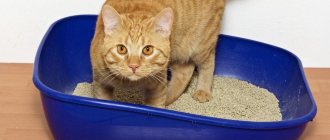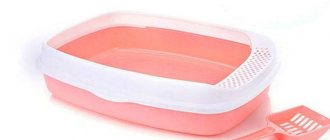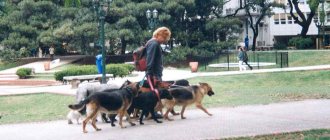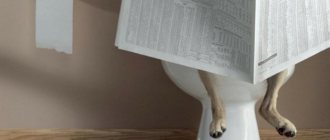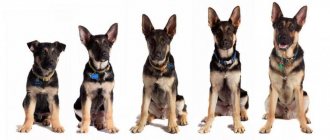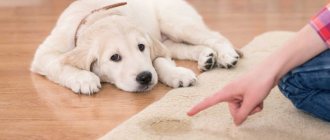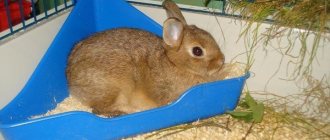The popularity of decorative dog breeds is largely due to the fact that they can be trained to use a tray. Not every owner has the opportunity to sit at home with a puppy for several months, running out into the street with him at the first natural call - for a busy person who is ready to walk the dog only once or twice a day, a diaper becomes a real salvation.
The dog’s habit of going to the toilet in a specially designated corner of the house helps to care for an elderly or injured pet, and also allows even a person with limited mobility to keep a four-legged pet. But its formation also requires basic knowledge and effort - you should read our article even if you plan to adopt a puppy from a breeder. Remember that in a new place the dog will need time to determine the place for the toilet. Natural difficulties also arise when retraining a pet that is already accustomed to relieving itself on the street.
At what age can a puppy be litter trained?
Puppies show the best results at the age of 4-5 months, but training can begin as early as 2-2.5 months. Don’t try to train a one-month old baby to a litter tray - due to its ineffectiveness, the idea will cost you your nerves. It is better to devote this time to establishing a trusting relationship with your pet and developing its social skills.
If you are adopting a puppy from a breeder - probably after 3 months of age - begin training the moment the dog arrives at home.
Popular sections:
Aquariums Sale of kittens and puppies Terrariums Products for cats Products for dogs
As for the timing of toilet training, they may vary depending on the conditions and individual characteristics of the pet. In conscious puppies learn to walk in a diaper on average in 2 weeks; some more time (about 2 months) is required to consolidate the skill.
The process can be speeded up by:
- later weaning from the mother or other adult dogs, when puppies begin to master the litter box, repeating after their older relatives;
- habituation of the animal by the breeder or previous owner;
- early weaning of the puppy if its parents did not go to the litter box or the pet was not trained in the previous home;
- absence of other animals and children in the house;
- long stay of the owner with the dog.
And remember, the older the pet, the more difficult it will be to retrain it.
Is it possible to litter train an adult dog?
Tray training an adult dog is difficult, but possible. This can be facilitated by the preservation of the senses, warm relationships with the owner and members of his family, as well as forced necessity (for example, the postoperative period). Be prepared to be patient - mastering the tray can take several months, and even a year to perfect the skill. If your pet has never used a diaper for its intended purpose before 12 months, it will take much longer for him to form a new habit.
Be sure to pay attention to your dog's toilet preferences. If she is used to walking, a roll of lawn grass, and subsequently a mat with artificial grass laid instead of filler, can “make friends” with the tray. If your pet rarely leaves the house, and chooses a place to suit his needs anywhere, you can train him to the litter box almost like a puppy.
Tray for dogs with grass
With the help of such a toilet, you will teach your puppy to go to one place, and after it the dog will be able to go for a walk on the street, because the grass is the same as on the street. This toilet will help you replace winter walks with decorative dogs. A mat with a herb simulator will give your pet special pleasure, after which the dog will relieve itself without fail.
This toilet's system will prevent odor from escaping for up to seven days. Covering the toilet will allow you to clean up your dog's feces without problems, and you will save money on previously offered diapers.
Currently, there are many modifications of dog trays on the market. However, it is quite possible to make such a device yourself.
What breeds of dogs go to the litter box in the house?
Not all dog breeds are equally willing to be swaddled. Breed temperament and intellectual abilities must be taken into account. Among others, the following are considered “excellent” in the toilet issue:
- Yorkshire, toy and other small terriers;
- Pekingese and Japanese Chins;
- miniature dachshunds and poodles;
- Chinese Crested;
- Pomeranians;
- Pugs.
The more decorative the breed, the higher the pet’s chances of learning simple science.
How to choose a litter box for your dog?
When choosing a dog litter box, you should not rely only on your own measurements - it would be much better to “try on” the container and place your pet in it. For this reason, it is better to buy the first tray offline or on the recommendation of an experienced consultant. Do not forget that puppies grow very quickly, and therefore it is better to use a toilet for growth. There is a high chance that your four-legged friend will not like a tray that is too small - dogs prefer space.
Under no circumstances should you buy a cat litter box for your pet - cases of dogs being accustomed to them are known, but extremely rare.
The general principle of dog litter trays varies little depending on their type. A dog toilet is a tray made of plastic or galvanized metal, the bottom of which is covered with a diaper or a rubberized mat or grate. The smaller the breed or height at the withers, the lower the sides of the toilet should be. So, for Chihuahuas they often produce bellyless models.
For male dogs, models are produced with a special post, which allows you to avoid marks on walls and furniture. The post usually has a system of attachment to the grille, which allows you to rearrange it if necessary.
For owners with allergies, we can recommend trays with clamps, thanks to which the absorbent diaper is securely fastened, preventing the spread of odor throughout the house. Remember that the filler in devices of this type needs to be changed more often.
Mode
In general, it will be useful to monitor the puppy for another purpose. Like people, dogs, given a standard diet, have a predictable habit of going to the toilet some time after eating and drinking. Catch him. After a certain interval, simply pick up the puppy in your arms and carry him to the tray. At the same time, you should not press it too hard against your wide chest, as there is a possibility of a “colander effect”!
By the way, this often happens to pug owners. These dogs are extremely “aristocratic” and sometimes do not tolerate the slightest violence against themselves. Simply put, they are able to describe you solely out of petty revenge.
If you do everything correctly and on time, then within a few days the animal will begin to run to the potty on its own without your participation. Of course, failures are possible... but you are teaching a small dog, and therefore there is no need to swear and shout. You'll just ruin the whole thing.
Do not try to hold the baby in the tray under any circumstances, as the puppy will be terribly scared. Of course, he will probably be able to pee, but it will not be a conscious “action”, but a simple attack of bear disease. Next time he won’t come close to the tray, remembering the terrible trials that you prepared for him there.
Dog Litter Litter
Unlike cats, who instinctively bury their excrement, dogs have no need for loose litter. For them, the absorbent characteristics of the material are a priority, since a clean dog would never go to a dirty, wet litter box.
Therefore, in trays without a grid, the most popular material for covering is newspaper or other paper, as well as a diaper. If your dog moves it with his paws or likes to play with the sheets, you might want to consider installing a grill or changing the litter.
The second place is occupied by special mats with artificial grass, or rubber options with special grooves. Rare dogs go to sawdust or other traditionally “cat” litter. Some owners even use hay as bedding.
It is often possible to do without a tray - if the dog is careful and does not move the toilet, you can lay a disposable or reusable diaper on the floor. The first option is more convenient in terms of time costs and is well suited for allergy sufferers, while the second is more economical and environmentally friendly. You can read more about diapers here.
Benefits of having your dog use the litter box
If you manage to train your dog to go to the litter box or retrain it, you can forget about the need to get out of a warm bed at 5 am, so that when all your neighbors are still sleeping - to walk your pet, you will not have to worry about what if you stay late after work - your four-legged friend will mark your favorite carpet, you will save on purchasing clothes and shoes for dogs, and the need to wash your paws after a walk will also disappear by itself. And, lastly, you will reduce the risk that the dog will eat something during a walk (about perverted appetite in dogs), run away, or be bitten by other dogs (the risk of contracting rabies from unvaccinated dogs and zoonotroponotic diseases that are dangerous for you and me , very large) – to a minimum.
Choosing a location for the dog litter box
Initially, poor placement of the toilet can cause a lot of “misfires” in the puppy and lead to conflicts with the owner and family members. When choosing a location for your dog litter box, consider the following principles:
- the place should be convenient for both the puppy and the owner, since changing the location of the toilet has a negative impact on training;
- make sure that, in addition to the diaper, there are no other soft absorbent materials on the floor, such as carpets or rags;
- Try to choose a room where you can limit the puppy's movement.
For very small pets, you can build a fence, gradually increasing the living space from 1.5 sq.m as they grow. The fewer places to relieve yourself, the higher the likelihood that the dog will choose a diaper as a toilet.
How to train a dog to use a litter box?
1. Limit the space you can move. The most convenient way would be to organize the puppy’s living space so that it is always convenient for you to keep an eye on him. This will help you respond in a timely manner to your baby’s attempts to sit down.
2. For the time being, remove all soft bedding from the premises accessible to the puppy. Natural cleanliness often becomes the reason that a pet chooses the surface for the toilet that best absorbs urine and retains odors. What absorbs moisture better than carpets?
3. Choose a location for the litter box based on your puppy's preferences, or place it further away from the aisle.
4. Follow the regime. Usually puppies run to pee after waking up and poop after eating. Transfer your pet to the tray in advance, gently talking to him and stroking him. Don't forcefully hold your dog in the crate, but gently return him if he tries to run away without getting the job done. Do not let the puppy run around the entire apartment until he has had a bowel movement.
5. Be sure to reward your pet with vocal praise and a favorite treat immediately after completing the process.
6. Do not yell at the puppy, do not hit or humiliate him if he wanders by. If you catch your pet committing a crime, loudly and unexpectedly say “ugh,” clap your hands, and scold the puppy. A look of shame (ears flattened, pleading look) is more than enough. If you are late and an incident occurs, remove the feces and wash the floor thoroughly so that there is no smell left. Before doing this, it is advisable to dip a piece of paper in them and put it in the tray, leaving a kind of olfactory anchor for the puppy.
Do dogs need a litter box?
Breeders of four-legged friends are divided into two camps: some are supporters of using this accessory, others are fierce opponents of using a home toilet for dogs. In their own way, each of these opposing sides is right.
How to accustom a toy terrier to a tray and a diaper
On the one hand, a litter box at home is a real salvation if:
- the baby is still too small and not accustomed to relieving himself on the street;
- the dog is in quarantine before or after vaccination;
- the dog is sick and physically cannot walk outside.
On the other hand, experts point out that training a dog to use a litter box is a road to nowhere, since the pet instantly gets used to the fact that it does not require any effort to walk.
For your information! Gradually, the animal loses the ability to endure need from walk to walk, condemning the owner to the constant need to monitor the freshness of the litter in the tray and the cleanliness of the area around it.
Illness is one of the reasons why a dog goes to the toilet in a litter tray
How to deal with learning difficulties?
If your dog does not use the litter box, take a closer look at his behavior and surroundings. Perhaps alternative bedding is preferable to diapers for her - in this case, it is worth excluding the pet’s access to carpets, beds, upholstered furniture and secluded places, such as boxes. Or the animal prefers dark corners, where it can relieve itself away from its owner’s eyes. This behavior is usually typical of adolescents and adult dogs that have undergone incorrect and traumatic training from previous owners.
When keeping a puppy, remember that little pets are just learning to control urination and defecation, and therefore trays and diapers should be within walking distance so that a child who is playing or overeating has time to reach them. Subsequently, the number of toilet places can be gradually reduced.
Dogs already accustomed to the street may look for a substitute for grass - for example, terry blankets. Lay them on a special mat or use natural materials as bedding for the first time.
If your pet is too clean or you are away from home for a long time, provide him with several litter trays so that he can go to the toilet without getting his paws dirty. Also, protest may be caused by the tray being too small, unstable, or having inconvenient sides.
For a dog of any age that has only recently arrived in the home, mastering the living space is inextricably linked with setting boundaries. Being territorial animals, dogs instinctively mark their territory, often marking places where boundaries may be violated by strangers - near doorways and window openings. Do not forget to limit the area of movement for the first time, and also do not take into bed an animal that does not yet control its urges.
If your pet came to you as an adult, pay attention to whether it gets along with your household, whether it gets enough attention, and whether it competes with other pets. In some cases, violation of toilet rules may indicate diseases of the genitourinary tract, conflict with someone at home, or boredom. Sometimes castration of a pet that is not intended for breeding helps solve the problem. Trays with posts are offered for breeding dogs to demonstrate their dominance.
Remember that dogs prefer to go to the toilet in the same place, which retains their scent. Be sure to clean the wrong areas using household and special products to avoid relapses. Sometimes products such as “Antipis” and “Antiodor” for surface treatment help solve the problem.
If none of the methods helped you, as well as the recommendations of the breeders, think about purchasing dog diapers. They will also help you avoid unpleasant incidents at a party.
Dog tray with post
This tray is designed specifically for male dogs. He will teach kids to go to relieve themselves “correctly”; an adult dog will feel comfortable using a specially designed post, and not furniture that may come in his way.
A tray with a post for dogs is larger and deeper than a cat's; the filler is a hygienic diaper, not sand. The grid that is attached to the top of the tray helps keep your dog's paws dry and clean. The column is not rigidly fixed; it can be installed anywhere in the tray. The material from which this tray is made does not cause any allergies and it is non-toxic, does not absorb odors and is easy to clean - these are, of course, the main advantages of this type of tray. In order for the dog to consider the tray his own, you need to place it near the bedding or bowl of food.
What not to do?
Be consistent and clear in the process of training your puppy, try to maintain his sense of trust in a person and safety in your society. Also remember that to create a conditioned reflex, it is necessary to maintain the shortest possible time intervals between the action and the reward. Absolutely not worth it:
- praise or blame your pet upon discovering a pile or puddle, if they were not made in your presence;
- spanking or otherwise physically punishing the dog, especially before 4 months of age when puppies are especially susceptible;
- use only negative motivation and do not reward your pet after correct actions;
- forget about negative reinforcement (even if you are soft-hearted, to raise a dog you still need to establish what is acceptable and what is not);
- punish the pet by depriving it of food or entertainment;
- lock it up with the stool or poke your nose into it;
- use ammonia detergents (they may have the opposite effect).
It is very important to reinforce in the dog’s mind the sequence “if you missed the tray, you met with condemnation.” If you punish the puppy not for the prank itself, but for the excrement that is subsequently discovered, he will most likely begin to hide traces of the crime - for example, lick it off in fear of punishment or shit in secluded corners.
Begin!
A puppy is one thing, a tray... but you guessed wrong! There should be at least two trays, or even three. Why such difficulties? The fact is that the dog will not immediately be able to decide on the place where it will be most comfortable for him to write and more. This is especially true if you are training a dachshund: these animals are “burrowers” for hunting purposes, and they themselves often love solitude. Because of this, they often set up toilets in the most remote and inconvenient places.
First, you will have to keep an eye on the little fidget: you need to seize the moment when he is clearly in the mood to make a puddle. At this moment, carefully, without making sudden movements or making piercing sounds, you need to transfer it to the tray. Pet the puppy and calm it down. Make sure he completes his plans. Give your pet something especially tasty.

